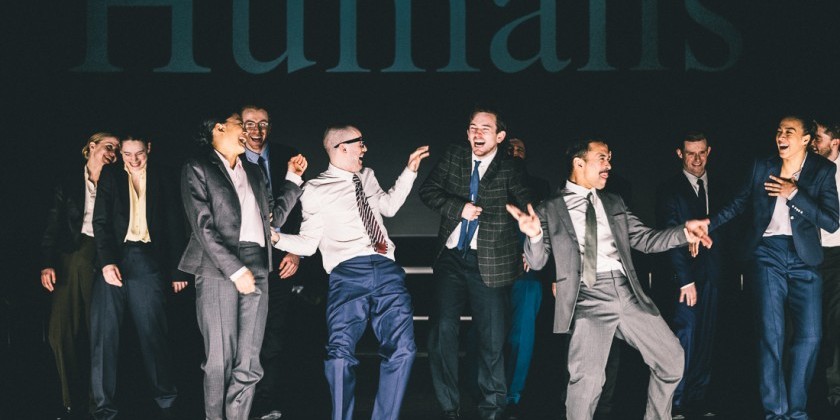IMPRESSIONS: New York City Ballet's Spring Season: Ravel & Reflections

New York City Ballet's "All Ravel" program
Celebrating the 50th anniversary of their 1975 Ravel Festival
Venue: David H. Koch Theater, Lincoln Center
Spring Season: April 22 – June 1, 2025
New York City Ballet's recent spring season successfully introduced some young dancers in major roles. In an earlier review I mentioned David Gabriel’s ability to take an audience on a journey and turn a familiar piece into an exciting adventure.
Watching two casts in the company’s Ravel program let me experience the dances in completely different ways.
Young corps de ballet dancer Dominika Afanasenkov takes on George Balanchine's Errante (formerly known as Tzigane) and works through the piece with hardly any flirtation. Afanasenkov does play with rhythm and timing, but she lives through it all rather than present a dance to an audience. The gypsy’s itinerant way of life is not always fun and games, as Mira Nadon (in the alternate cast) wants you to believe.
Afanasenkov slices the space with sharply edged arm movements, and thus visualizes the sounds of the violin (played by Lydia Hong). She bourées backwards speedily and with authority. When her partner, Chun Wai Chan, wants to turn her solo into a duet, she seems skeptical, and her body language clearly reads: Where were you when I tended to all the chores? Chan charms his way closer to her with impressive jumps, kicks, and turns, and she finally decides to tolerate him.
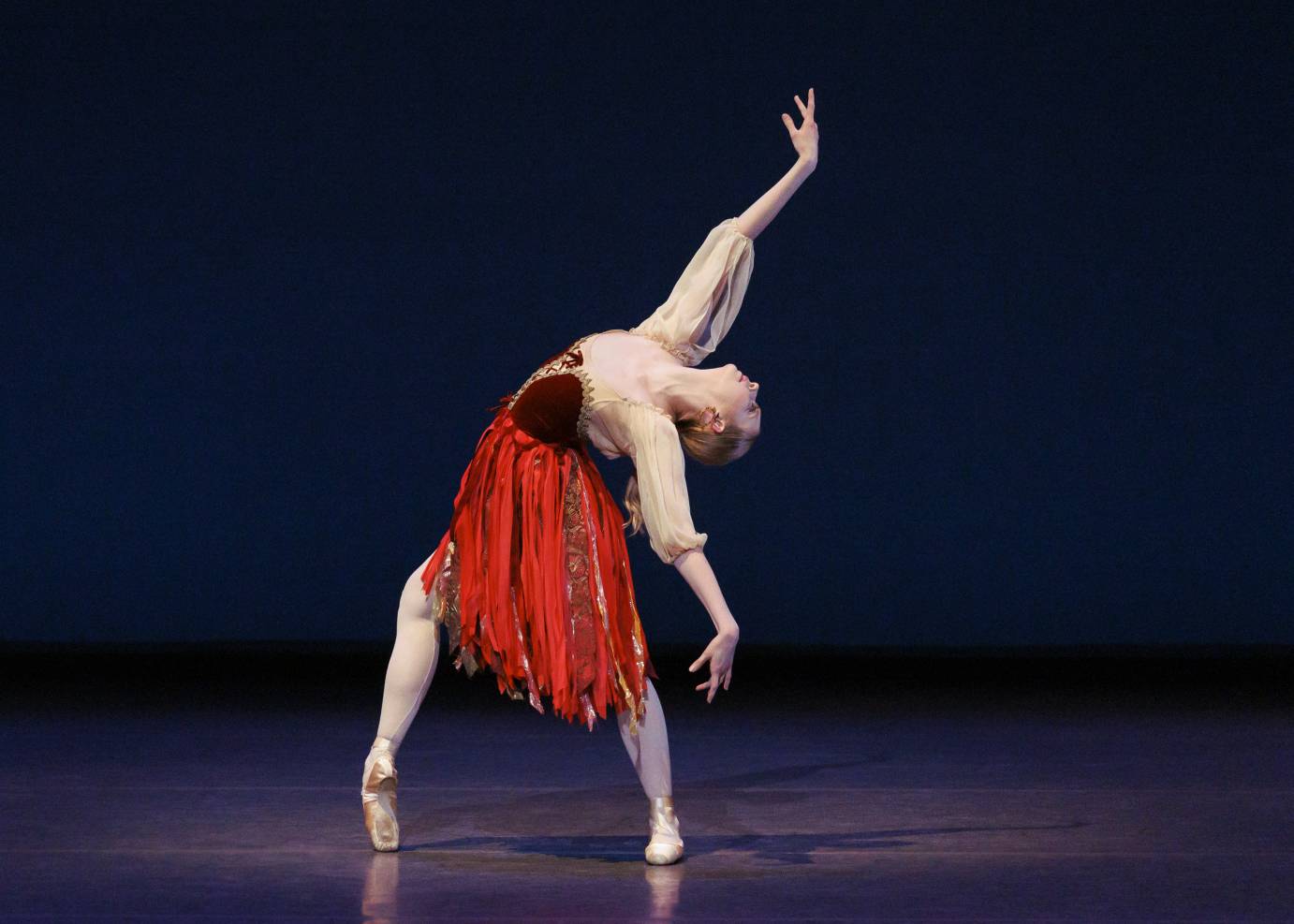
Dominika Afanasenkov in George Balanchine’s Errante. Photo: Erin Baiano
Nadon seduces the audience, and when Aaron Sanz joins her, no one notices. Either way: Errante celebrates the spirit of a woman. Whether she embodies a no-nonsense traveler, or a playful vixen, a man does not amount to a necessity. Four background couples simply dress the upstage area.
Celebrating composer Maurice Ravel 50 years after the company presented a group of works created for its 1975 Ravel Festival also means looking back at dances that are old.
Jerome Robbins' In G Major, with scenery and costumes by designer Erté, might seem like a throwback to the Art Deco period during which Ravel composed his piano concerto. Yet because the long-lived Erté (1892-1990) not only happened to be around at the time, but also is widely revered as the father of Art Deco fashions in stage design, the ballet’s sleek yet playful look feels authentic.
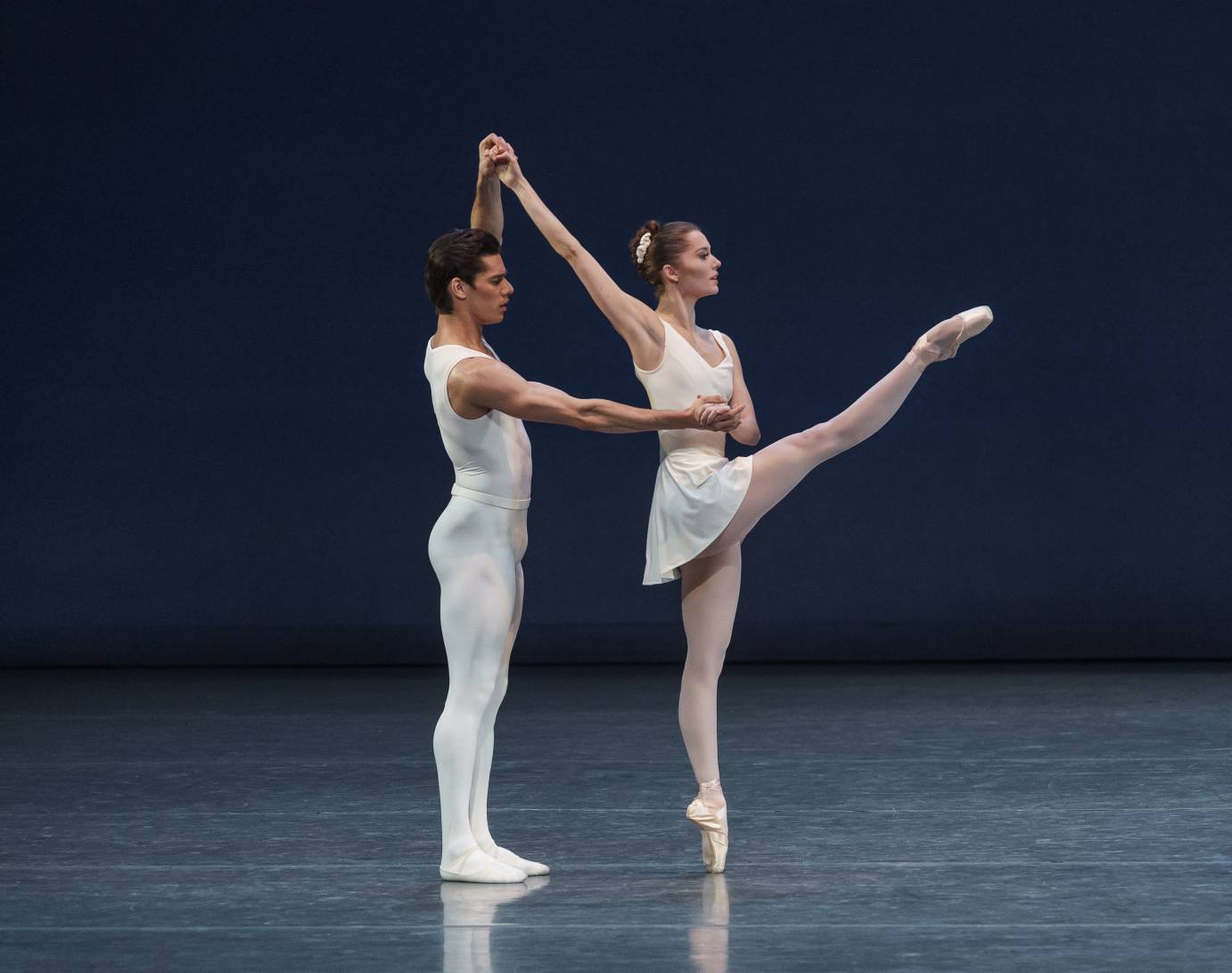
Jovani Furlan and Unity Phelan in Jerome Robbins’ In G Major. Photo : Paul Kolnik
The two interpretations of the work’s long, central pas de deux could not be more different. Unity Phelan and Jovani Furlan resemble porcelain statues tha
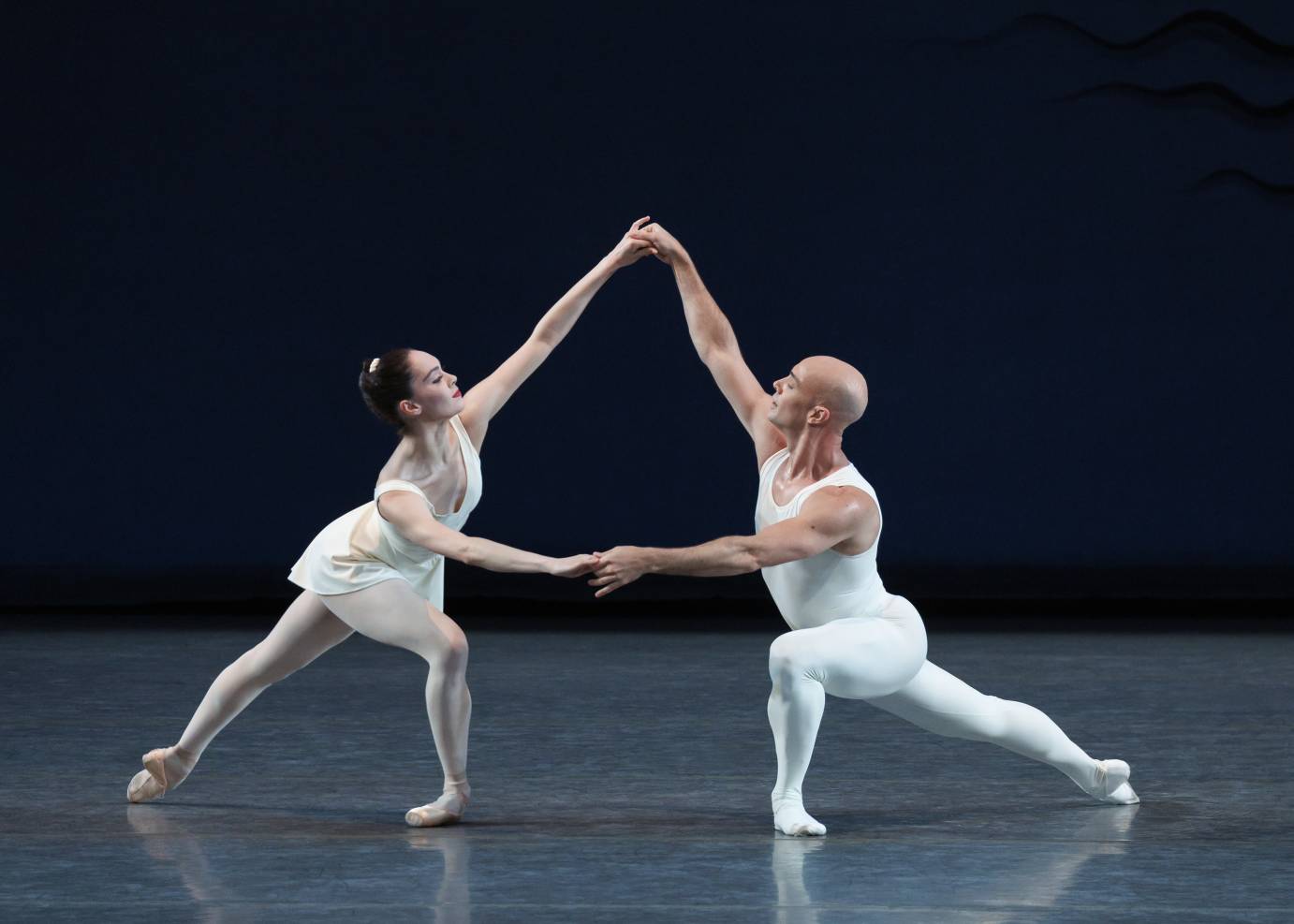
Mira Nadon and Tyler Angle in Jerome Robbins’ In G Major. Photo: Erin Baiano
In the same work, but with a different cast, Mira Nadon’s playfulness invites comparison to the humorous elegance for which Erté is known. Her excellent partner, Tyler Angle, commits to a joyful afternoon in the central duet, sandwiched in between frolicking groups splashing by the beach. Rather than pick up a statue with outstretched arms, Angle moves in close with a “temps lié” (a transfer of weight through an undercurve or demi-plié) to place himself on Nadon’s axis. This not only makes a lift much easier to execute, but also lends their partnership instant intimacy. A buoyant run in a generous semicircle has the partners turning to and fro as they continually change hands. Their excitement makes me want to dance along. I am touched by this resounding intimacy that unlocks the gate between onlooker and performer.
I hope that Robbins, who was known to be a stickler for correct steps, would be pleased to see his work interpreted in such divergent ways. His choreography holds up no matter what the temperature of the performance.
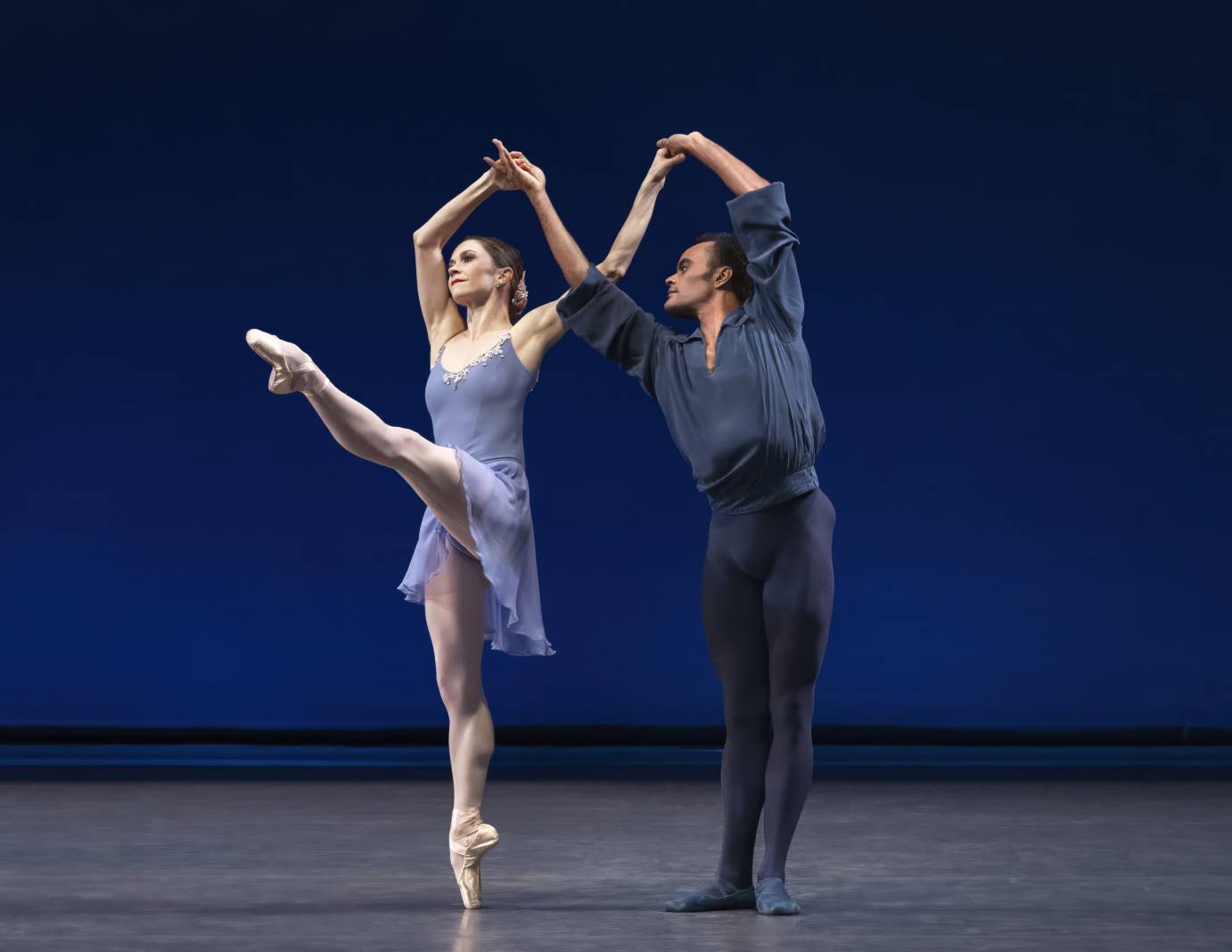
Megan Fairchild and Taylor Stanley in George Balanchine’s Sonatine. Photo: Erin Baiano
Balanchine’s Sonatine seems minor in comparison, but gives a glimpse of lovely partnering by Megan Fairchild and Taylor Stanley, while this choreograp
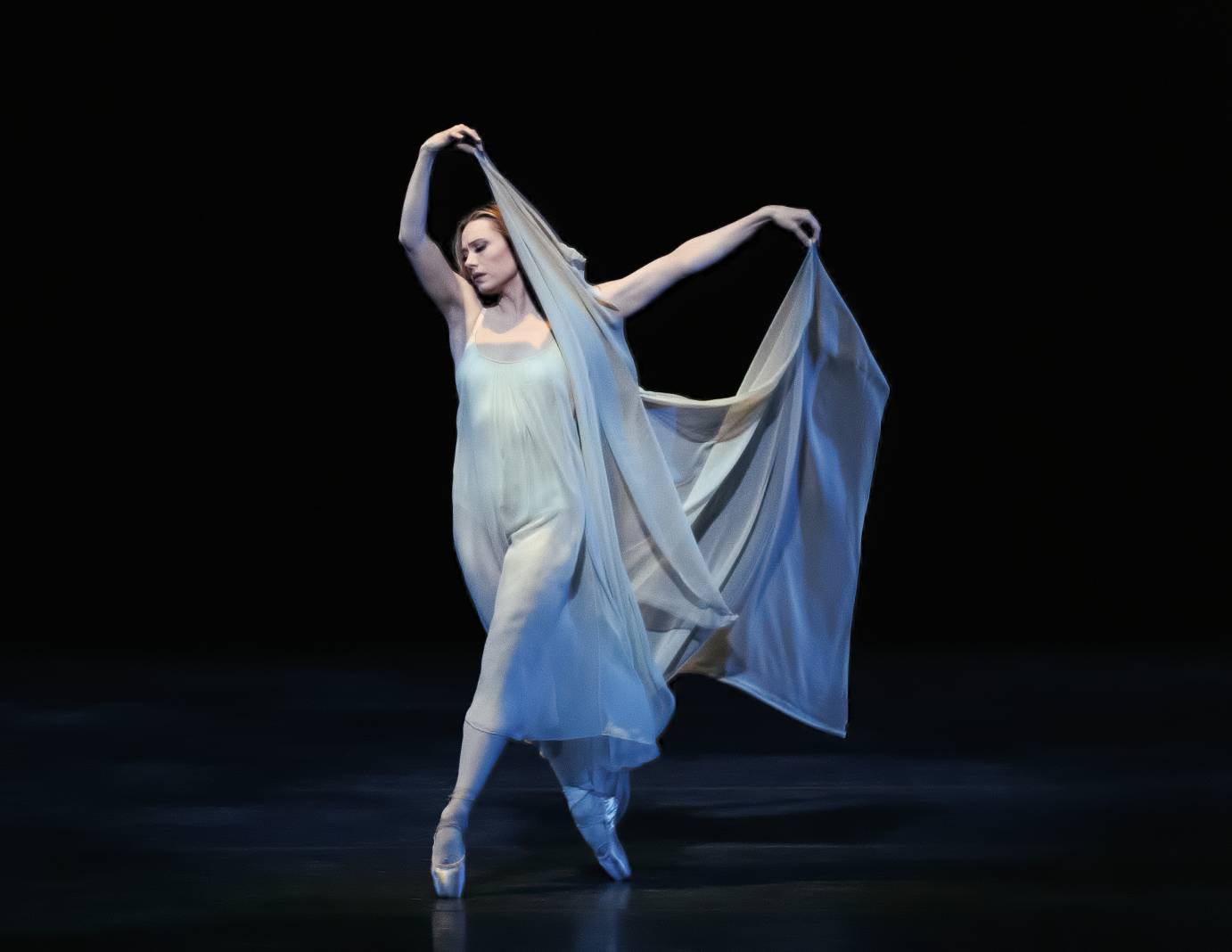
Sara Mearns in George Balanchine’s Pavane. Photo: Erin Baiano
The closing number, La Valse, with scenery by Jean Rosenthal and costumes by Karinska, is the only ballet on this program that premiered earlier than 1975. Created in 1951, Mr. B’s gothic tale of Death taking the Maiden opens with Ravel’s Valses nobles et sentimentales for a long party scene that gives soloists and demi-soloists moments to shine. Here Megan LeCrone reminds me what a beautiful dancer she is. The maiden, danced by Indiana Woodward or Unity Phelan, cannot resist the offerings of a necklace and gloves that lead to her demise. Taylor Stanley and Jules Mabie partner faultlessly, and Death, as danced by Chun Wai Chan or Andrew Veyette, cuts a handsome figure. Yet here, for once, Balanchine’s choreography is no match for the glorious music so powerfully played by the New York City Ballet Orchestra under the baton of Andrew Litton.
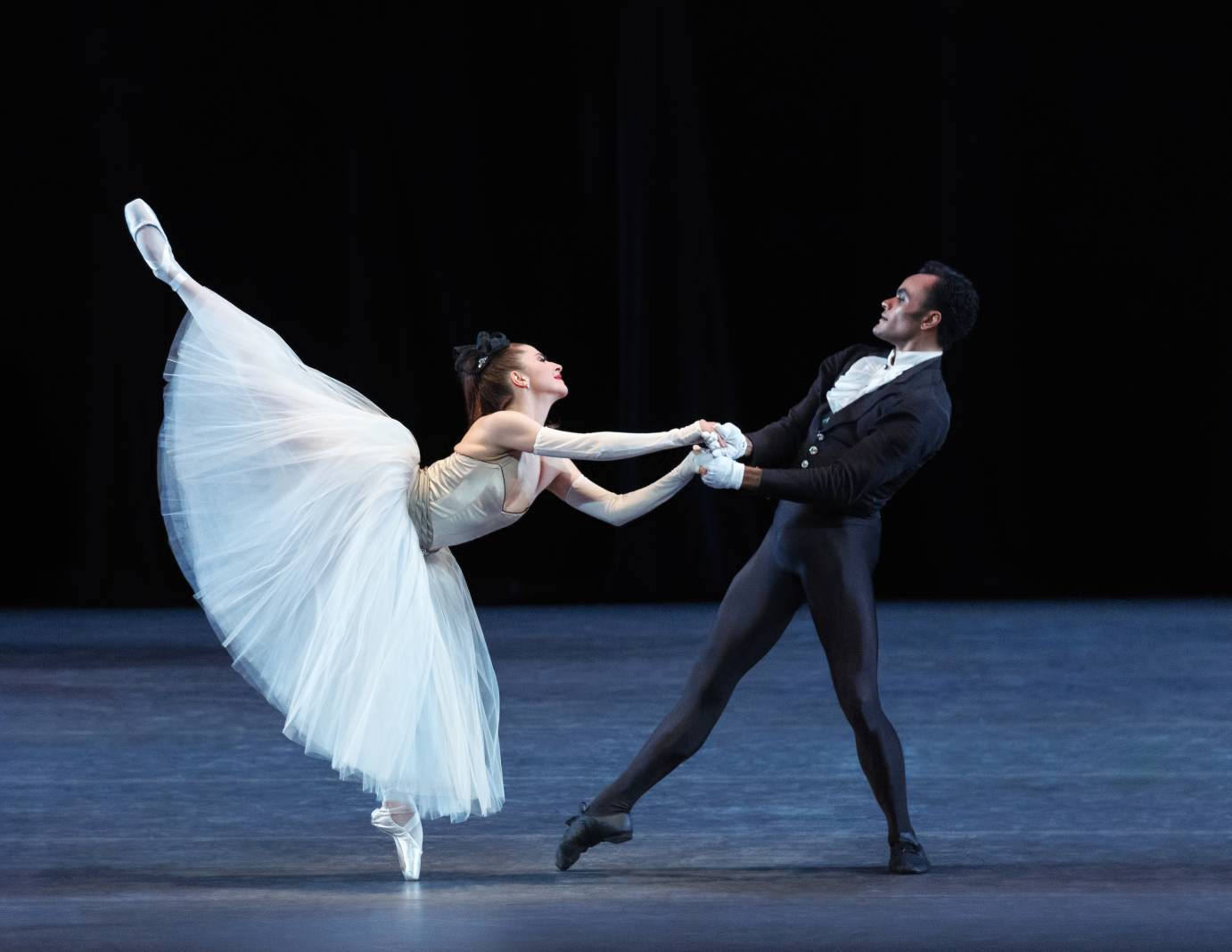
Indiana Woodward and Taylor Stanley in George Balanchine’s La Valse. Photo: Erin Baiano
Highlights and lowlights of other evenings include yet another star turn by Taylor Stanley in Justin Peck’s recent work "Mystic Familiar." Willowy yet vigorous, Stanley commands the stage with graceful beauty. The work looks to be a Twyla Tharp-inspired AI world; and from the very moment a group of puffy-sleeved aliens cross the stage, I am hooked. Peck knows how to move groups in ever-changing configurations. I look forward to seeing this piece again, and experiencing Peck’s exciting vision to music by Dan Deacon, with costumes by Humberto Leon, scenery by Eamon Ore-Giron, and lighting by Brandon Stirling Baker.
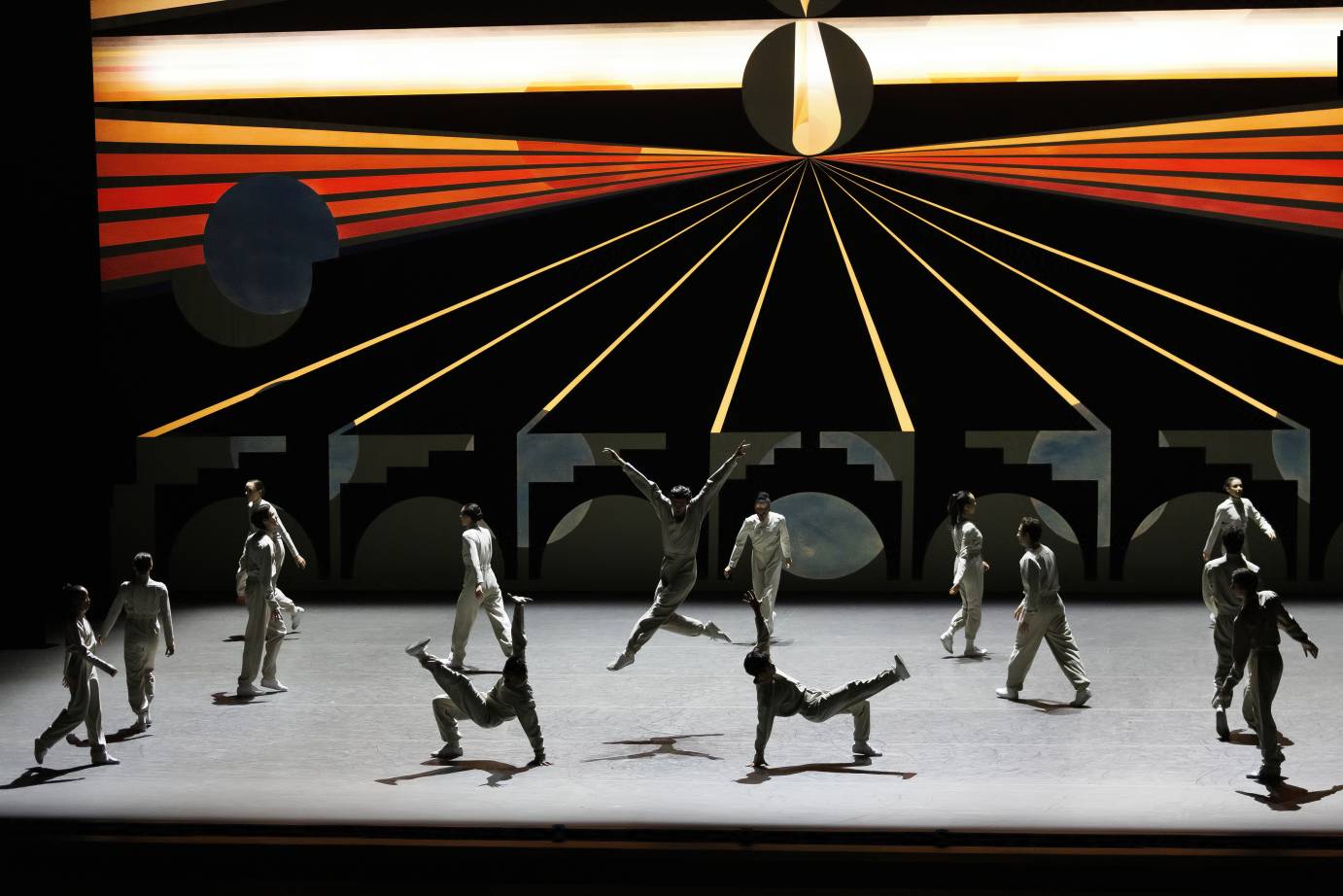
New York City Ballet in Justin Peck’s Mystic Familiar. Photo: Erin Baiano
Kyle Abraham's new When We Fell was originally produced as a film during the Covid-conditioned 2021 Digital Season. Scored for four pianos, the work with a mirror along its back wall at first resembles an aquarium, but when the mirrored set flies upward, the earth tones of set and costumes give off an arid beauty. A “terrarium” therefore seems the more apt description, in which the inhabitants move at various speeds and often without a frontal focus. The ballet has a wonderfully modern concept of space, and the dancers prove to be creatures of wonder.
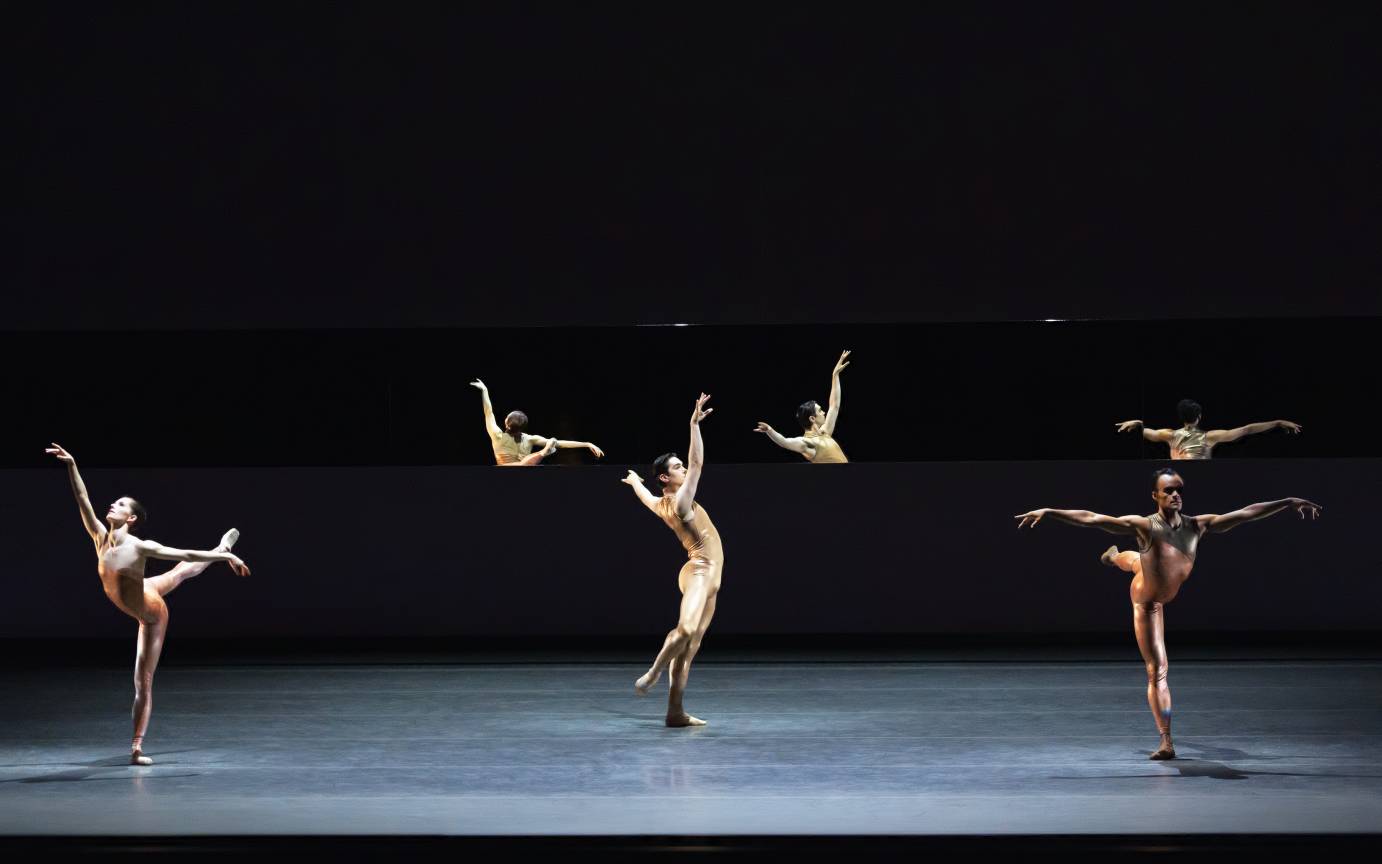
As impressive as is Joseph Gordon’s star turn as a grieving father, or soldier, in Alexei Ratmansky's Solitude, I feel manipulated by the inclusion of a dying child on stage. Ratmansky paid attention when he danced in Antony Tudor’s Dark Elegies, and he repeats that master choreographer’s use of semi-cupped hands as an expression of grief. That he also uses Mahler to underscore the sentiment proves how derivative Solitude really is. While Tudor managed to stir up one’s emotional core through the absence of children in Dark Elegies, the kid in Solitude demotes the subject of war and loss to a soap opera.
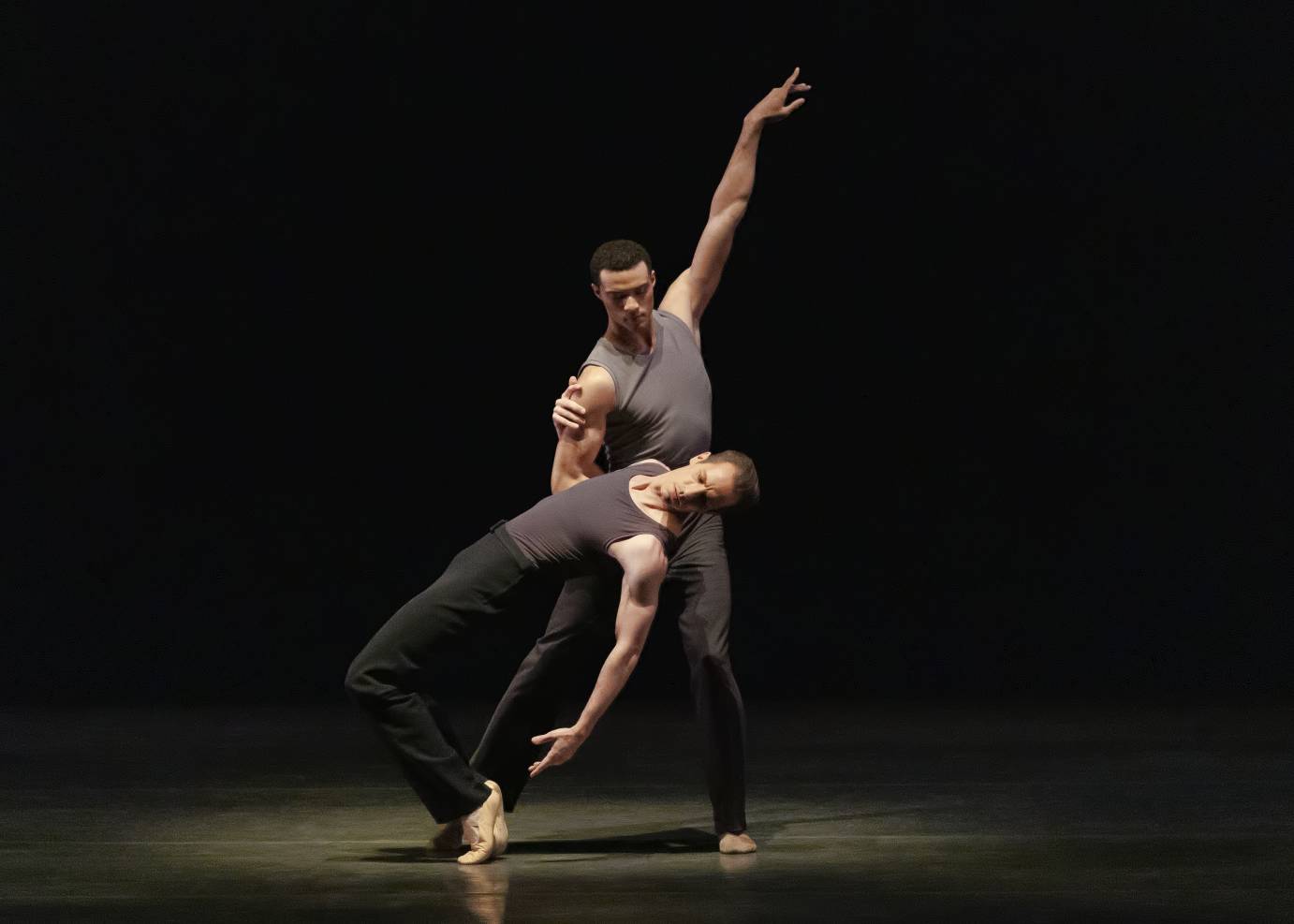
Andrew Veyette and Preston Chamblee in Lynne Taylor-Corbett’s Chiaroscuro. Photo: Erin Baiano
The recently deceased Lynne Taylor-Corbett's 1994 creation Chiaroscuro returned to the repertoire. I was surprised how much I enjoyed seeing it again. While I chiefly remembered it as a vehicle for the outstanding Jock Soto, I did not recall and appreciate Taylor-Corbett’s ma
On May 21, music director Andrew Litton shared an especially insightful session of See the Music… and introduced the score for Chiaroscuro by Francesco Geminiani (after Arcangelo Corelli’s Op. 5, No. 12) to a spellbound audience.
SEASON CASTING
THURSDAY EVENING, MAY 1, 7:30 PM (Guest Conductor: Hollingsworth) PAQUITA: Nadon, Gordon, O. MacKinnon, *Laracey, E. Von Enck, Kikta, *M. Williams, Pereira, Gabriel A SUITE OF DANCES: *Mejia [Solo Cello: Holman] pause AFTER THE RAIN PAS DE DEUX: **M. Miller, Chamblee [Solo Piano: Scales, Solo Violin: Nikkanen] BRANDENBURG: Woodward, *Mabie, Phelan, *P. Walker
FRIDAY EVENING, MAY 9, 7:30 PM (Conductor: Litton) DIVERTIMENTO NO. 15: Adams, Pereira, Phelan, Gerrity, M. Fairchild, Chan, Zuniga, Klesa VIENNA WALTZES: *LaFreniere, Sanz, Woodward, Ulbricht, *Pollack, Schumacher, M. Miller, *Knight, Phelan, *Chamblee
SATURDAY EVENING, MAY 10, 7:30 PM (Conductor: Sill) BENEATH THE TIDES: *Woodward (replaces T. Peck), Mabie, Sanz, *Phelan, *Chamblee [Solo Cello: Perkyns] SOLITUDE: Mearns, Nadon, Woodward, Adams, Hod, Laracey, Maxwell, Gordon, Chan, Takahashi, Abreu, *Flacke (replaces Bolden), Coll, *Klesa (replaces Flacke), *Schmidt++ MYSTIC FAMILIAR: Bradley, Corti, Kikta, M.T. MacKinnon, T. Peck, Targosz, M. Williams, *Chamblee (replaces Bolden), Coll, Gabriel, Klesa, Stanley, Takahashi, P. Walker
TUESDAY EVENING, MAY 13, 7:30 PM (Conductor: Sill) BENEATH THE TIDES: Woodward, Mabie, Sanz, Phelan, Chamblee [Solo Cello: Perkyns] SOLITUDE: Mearns, Nadon, Woodward, Adams, Hod, Laracey, Maxwell, Gordon (replaces Ulbricht), Chan, Takahashi, Abreu, Flacke (replaces Bolden), Coll, Klesa (replaces Flacke), Schmidt++ MYSTIC FAMILIAR: Bradley, Corti, Kikta, M.T. MacKinnon, *Pollack (replaces T. Peck), Targosz, M. Williams, Chamblee (replaces Bolden), Coll, Gabriel, Klesa, Stanley, Takahashi, P. Walker
WEDNESDAY EVENING, MAY 14, 7:30 PM (Conductor: Litton) IN G MAJOR: Phelan, Furlan [Solo Piano: Kim] SONATINE: M. Fairchild, Stanley [Solo Piano: Chelton] pause PAVANE: *Mearns pause ERRANTE: Nadon, Sanz [Solo Violin: Nikkanen] LA VALSE: Woodward, Stanley, Chan, Weber, *O. MacKinnon, Henson, Pollack, Coll, LeCrone, *Gruska (replaces Grant), *Durham, *Clark, *Lundgren
SATURDAY MATINEE, MAY 17, 2:00 PM (Conductor: Litton) DIVERTIMENTO FROM “LE BAISER DE LA FÉE”: M. Fairchild, Gordon, *Collett, Sell WHEN WE FELL: Phelan, Woodward, Bradley, Stanley, Gabriel, Takahashi, Villarini-Vélez, Mabie (replaces Grant) [Solo Pianos: Gosling, Baldwin, Kim, Moverman] pause CHIAROSCURO: Laracey, O. MacKinnon, Pollack, Veyette, Chamblee, Ulbricht ODESA: Phelan, E. Von Enck, Maxwell, *P. Walker (replaces T. Angle), Stanley, Veyette [Solo Violin: Nikkanen]
TUESDAY EVENING, MAY 20, 7:30 PM (Conductor: Litton) IN G MAJOR: Nadon, T. Angle [Solo Piano: Kim] SONATINE: M. Fairchild, Stanley [Solo Piano: Chelton] pause PAVANE: Mearns pause ERRANTE: Afanasenkov, Chan [Solo Violin: Hong] LA VALSE: Phelan, Mabie, Veyette, Weber, O. MacKinnon, Henson, Pollack, Coll, LeCrone, Gruska (replaces Grant), Durham, Lundgren, Clark
WEDNESDAY EVENING, MAY 21, 7:30 PM (Conductor: Litton) DIVERTIMENTO FROM “LE BAISER DE LA FÉE”: T. Peck, Mejia, Jones, C. Von Enck WHEN WE FELL: Phelan, Woodward, Bradley, Stanley, Gabriel, Takahashi, Villarini-Vélez, Mabie (replaces Grant) [Solo Pianos: Gosling, Baldwin, Kim, Moverman] pause SEE THE MUSIC pause CHIAROSCURO: Laracey, O. MacKinnon, Pollack, Veyette, Chamblee, Ulbricht ODESA: Mearns, Woodward, M. Fairchild, T. Angle, Gordon, Ulbricht [Solo Violin: Nikkanen]
THURSDAY EVENING, MAY 29, 7:30 PM (Conductor: Litton) A MIDSUMMER NIGHT’S DREAM: TITANIA: Gerrity; OBERON: Mejia; PUCK: *Villarini-Vélez; HIPPOLYTA: LeCrone; THESEUS: Knight; TITANIA’S CAVALIER: Sanz; HELENA: Pollack; DEMETRIUS: *Abreu; HERMIA: Pereira; LYSANDER: *Zuniga; BUTTERFLY: C. Von Enck; BOTTOM: Nelson; DIVERTISSEMENT: T. Peck, T. Angle









